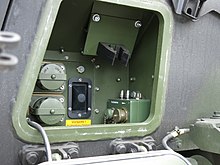Puma (German infantry fighting vehicle)
[8] The companies responsible for this project are Krauss-Maffei Wegmann and Rheinmetall Landsysteme, which created a joint venture, Projekt System Management GmbH (PSM).
Its aim was to collect ideas for a common base vehicle that could be used for a variety of tasks including that of the APC, IFV, air defense and replacing and assisting the MBT in the frontline combat role.
[3] That same year, the German Army (Heer) placed an order for the delivery of five pre-production vehicles and their logistics and training services at the end of 2004.
[13] On 6 December 2010, the first two serial vehicles were handed over to the German Bundesamt für Wehrtechnik und Beschaffung.
Trials included suitability for hot weather operations, firing and driving maneuvers in desert conditions, as well as firepower and mobility evaluations.
[15] On 13 April 2015, the Federal Office of Bundeswehr Equipment, Information Technology and In-Service Support (BAAINBw) granted authorization of use of the Puma IFV.
[3] The German Army will use €500 million to modernize 40 Pumas by 2023, with more effective weaponry and communications technology capable of rapidly providing a situation image and GPS coordinates to fighter jets.
[3] The cabin is air conditioned, NBC-proof with internal nuclear and chemical sensors and has a fire suppressing system using non-toxic agents.
The outer hull (minus the turret) is very smooth and low to minimize shot traps and the general visual signature.
The primary armament is a Rheinmetall 30 mm MK 30-2/ABM (Air Burst Munitions) autocannon, which has a rate of fire of 200 rounds per minute and an effective range of 3,000 m.[3] The smaller 30×173mm cartridge offers major advantages over, for example, the Bofors 40 mm gun mounted on the CV9040 because of a much lower ammunition size and weight.
The belt feed system provides a large number of rounds ready to fire, while the 40mm offers only 24 shots per magazine.
One is a sub-calibre, fin-stabilised APFSDS-T (T for tracer), with high penetration capabilities, mainly for use against medium armoured vehicles.
The ammunition type can be chosen shot-to-shot, as the weapon fires from an open bolt, with no cartridge inserted until the trigger is depressed.
While this is a smaller weapon than the western standard secondary armament (7.62 mm caliber MG), it offers the advantage that the crew can use the ammunition in their individual firearms.
The Puma was designed to accommodate additional armor, initially planning to offer three protection classes which are wholly or partly interchangeable.
The whole vehicle is protected against heavy blast mines (up to 10 kg) and projectile charges from below, while still retaining 450 mm ground clearance.
Almost all equipment within the cabin, including the seats, has no direct contact to the floor, which adds to crew and technical safety.
[34] Another crew safety measure is that the main fuel tanks are placed outside of the vehicle hull itself, mounted heavily armoured within the running gear carriers.
The fully stabilized 360° periscope (PERI RTWL by Hensoldt) with six different zoom stages offers a direct glass optic link to either the commander or the gunner.
Besides that, the periscope offers an optronic thermal vision mode and a wide-angle camera with three zoom stages to assist the driver, as well as a laser range finder.
The gunner has a thermal vision camera and laser range finder (identical to those on the PERI) and an optronic day sight, rounded off with a glass block.
The provisions for the rear cabin enable the passengers to be more active than previously in assisting the vehicle crew either directly through the vision blocks and hatches, or by observing one or more optronic feeds.
R&S SOVERON handheld (HR) and vehicle (VR) radios have been commissioned to equip Pumas of the German element of Very High Joint Readiness Task Force 2023 (VJTF 2023).
Firstly, its compact, lightweight MTU Diesel engine is unusually strong at 800 kW nominal output.
The vehicle prototypes have a five-road wheel decoupled running gear, and use a hydropneumatic "In Arm" Horstmann suspension to improve cross-country performance while reducing crew and material stress by limiting vibrations and noise.
This is to counter the front-heavy balance, inevitable because of the heavy frontal armor as well as the engine and drive train which are also situated at the front.
The serial production vehicles will have a symmetrical arranged six road wheel running gear as shown on released pictures by the manufacturer.
Puma orders were paused in December 2022 due to reliability issues, according to then defense minister Christine Lambrecht.
With modification, the Puma satisfied the technical requirements of the BCT Ground Combat Vehicle Program and was offered by SAIC and Boeing.
[53] The SAIC-Boeing team was not awarded a technology development contract for their Puma-based vehicle in August 2011, and then filed a protest.






